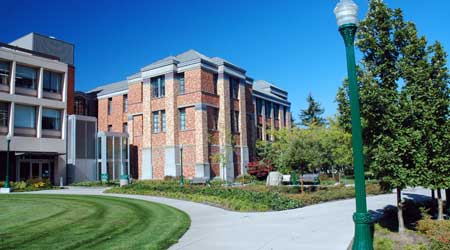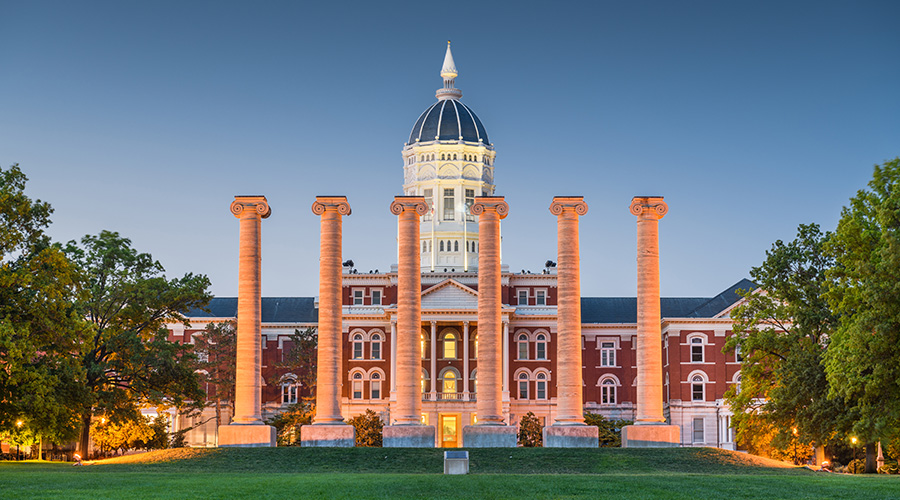 Hardscapes, including concrete sidewalks, stone walls and asphalt parking lots, are key components in creating a positive first impression among occupants and visitors.
Hardscapes, including concrete sidewalks, stone walls and asphalt parking lots, are key components in creating a positive first impression among occupants and visitors.Strategies and Tactics for Effective Hardscape Management
Comprehensive inspection and maintenance of asphalt, concrete and stone components can maximize the appearance of landscapes.
Hardscape management is a critical aspect of successful landscape management around institutional and commercial facilities. While hardscape components are not alive and do not grow, they do weather and change.
To properly plan future maintenance budgets and methods, as well as capital replacements, grounds managers need to understand these changes. Knowing the early signs of hardscape failures, as well as the proper way to repair them, will prove vital to managers and organizations.
Working the plan
The key to proper hardscape management is developing a written plan. A site’s hardscape management plan is a valuable resource that will guide managers’ decisions in a proactive manner.
In times of uncertain budgets and futures, developing this plan allows managers to make educated decisions on deferring maintenance without sacrificing capital assets. Managers need to customize the written plan to a site but do not need to follow a particular formula. Key sections to include are hardscape maintenance, specifications and expected costs.
The maintenance portion of this plan should identify the types of hardscapes present on a property, the preferred repair methods and materials, and maintenance techniques designed to prolong the life expectancy of the surface.
Hardscapes can be classified by their functions, which can include sidewalks, parking areas and paving, and walls. These structures often are made of asphalt, concrete, stone and brick.
Concrete considerations
Proper sidewalk inspections and repairs are essential for the safety of pedestrians on any property. As part of the hardscape management plan, workers should inspect sidewalks regularly for damage and problems. Sidewalks are traditionally concrete and are prone to cracking and movement from tree roots and other forces. Cracks in concrete are not a serious problem by themselves, but lifted or sinking concrete that creates a trip hazard is a serious issue that workers must correct.
While replacing lifted concrete sidewalks is the best option for long-term success, managers can turn to less expensive, short-term options to eliminate tripping hazards. Workers can select areas to repair during the inspection process, and they can grind the concrete panels that have lifted slightly to produce a level surface that is free of trip hazards. Typically, this method is suitable for areas that have lifted one-half inch or less. For larger raised areas, workers can install wedges to ramp up to the higher surface.
Workers can use mud-jacking to raise sunken concrete panels and restore the once-smooth surface. This process involves injecting a concrete slurry beneath the sidewalk to fill voids and raise the panel to its original height.
Any repair outside of replacement should be considered temporary. The actual repairs might last for years, but without correcting the underlying cause, the panels are likely to continue sinking or rising. Also, the repair work will be obvious, which might not be acceptable aesthetically.
Larger areas that are severely cracked or have disintegrated require patching. A proper concrete patch involves removing all loose material inside the patched area and filling it with concrete to match the existing surface grade.
For temporary repairs, asphalt cold patch can provide a reliable option that corrects safety issues. These patches eventually will fail because the asphalt will not create a proper bond to the cement. It provides a smooth, safe surface that workers can remove for proper concrete patching when time and budgets allow.
Bricks and pavers also are common materials for sidewalks and patios. Since they are individual pieces, workers can remove and replace broken or cracked pavers. They can use masonry or polymeric sand to fill spaces around a paver after it has been replaced and the repair is complete.
The most important aspect of brick and paver management is keeping a reserve stock of the original material for future replacement. Designs and sizes for these products change, so managers should not assume they will be able to find replacement materials. Keeping some extra of the original provides a long-term solution.
Spotlight on asphalt
Asphalt parking lots pose different challenges for grounds managers seeking to maximize the performance life of hardscapes. In typical times, these parking lots are generally full, and managers must plan large repairs in advance to block lots from use. Inspection is key to solving most asphalt problems early and at a lower cost. All asphalt fails, so early repairs can significantly prolong the life expectancy. These smaller repairs typically are not expensive, but they become exponentially more expensive when deferred.
Common asphalt failures include potholes, cracking and raveling. Potholes are easy to spot, and quick repairs can stop them from undermining a larger area. They form due to water seepage that degrades the subbase of the pavement. Vehicle traffic and freeze cycles make them worse.
Proper repairs involve removing loose debris, refilling and compacting the base, pouring new asphalt, and compacting the finished patch. Workers have two choices in repair material: hot mix and cold patch.
Cold-patch asphalt is readily available in bags and easily used. As with most easy fixes, the long-term effectiveness of cold patch can be poor, so managers should view them as a shorter-term fix to slightly prolong the life of pavement until workers can make proper repairs.
Hot-mix asphalt repairs are permanent as long as workers address the road base problems. This method of repair is more expensive but might be cheaper over time.
Cracking asphalt can have different causes, and each cause determines the proper maintenance technique. Fatigue cracks are signs of base failure and are common when the road base has not been properly compacted or has been affected by water. To properly fix these areas, workers must remove the pavement and address the underlying issue. Other cracks, such as longitudinal and transverse cracks, result from shrinkage. Workers can repair them by patching the cracked area without removal.
Raveling asphalt, a form of disintegration in older parking lots, occurs when the asphalt layer wears away as a result of age, poor asphalt mix or poor installation. Repairing a raveling pavement typically requires removal and replacement, so it is best to prevent it when possible by applying proper seal coats and regularly cleaning asphalt surfaces to improve the lifespan of pavements and reduce the likelihood of raveling.
Inspection insights
Regular maintenance practices as part of a hardscape management plan can reduce the need for and likelihood of larger replacements. Keeping hardscape surfaces clean extends the performance lives of these surfaces dramatically.
Dirt and dust clogs surfaces, reducing airflow and reducing the lifespan. Dirt will also stain concrete surfaces, reducing their aesthetic appeal. Workers need to monitor and address cracks that do appear in surfaces. Expansion joints can be added or caulked in concrete with minimal visual impact. For larger cracks that could impact the subsurface material, caulking might be appropriate.
Workers should inspect pavers and bricks to see if additional sand is required to prevent movement. Depending on the size gap between the bricks, workers can use different types of sand. Local distributors have more information about products that are best suited to a particular area. Application is simple and involves sweeping from multiple directions until all the gaps are filled.
Many hardscapes feature walls. Workers also must inspect them routinely to make sure any perimeter drains stay clear and free flowing. Poor drainage and water cause many foundation issues. Walls are typically made of stone, brick or pavers, and their life expectancy depends on the quality of construction.
Most wall failures and cracking are due to foundation issues and mortar problems. Workers can clean mortar failures and repoint them with fresh mortar. This method is commonly used on old brick walls and involves removing and replacing loose mortar.
For foundation issues that cause cracking or sinking, managers should bring in a structural foundation specialist to identify and address the problems. Foundation problems are fixable, but deferring the work can lead to wall failure. Managers should not let the potential cost of a repair prevent an inspection by a professional. The repair will be cheaper than replacement.
Hardscape management is not difficult, but managers do need to properly plan the program. Repairs are typically capital expenses that managers need to budget for well in advance.
They should take time to have workers properly document all pavement types on the property, as well as all of the typical repairs that will be needed. Workers also should inspect the hardscapes to determine the condition of components and plan repairs and replacements as needed.
Brandon Haley, CGM, is a grounds project manager for SSC–Services for Education a university and K-12 facilities services provider. He is a Certified Grounds Manager (CGM) through the Professional Grounds Management Society with 22 years of experience in the green industry.
Related Topics:












